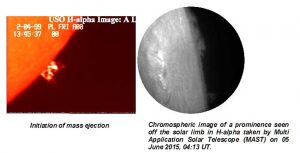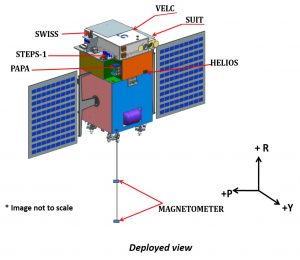ISRO – Indian Space and Research Organization are planning to launch its very first solar mission “Aditya-L1” within 2020.
ISRO is already famous for its low-cost missions and high success rate. Recently ISRO launched Chandrayaan-2 with great success, which will study the South pole of the Moon. All the international space agencies have also appreciated it. ISRO’s Chandrayaan-1 had discovered the existence of water on the Moon. To, add to the achievement, ISRO has already announced about the Gaganayaan – the very first Manned mission of ISRO. Not only that, but ISRO is also eyeing the sun with its solar mission “Aditya-L1”.
Here’s all you need to know about the solar mission “Aditya-L1”.
About ISRO’s first solar mission “Aditya-L1”

Solar mission “Aditya-L1” is the very first solar mission of the ISRO. Aditya-L1 will study the outermost layers of the sun, which is known as Solar Corona. Solar Corona lies thousands of kilometers above the sun’s surface. It is almost impossible to see Corona without a special instrument because the bright light of the Sun’s surface blocks the view of Corona. and has a temperature of more than a million degrees.
The temperature of the Corona is more than one million degrees. The high temperature of the Corona is still a mystery for the solar physicists.
Why the name, “Aditya – L1”?
Solar mission “Aditya-L1” was named Aditya-1 earlier and it was supposed to be a 400kg class satellite carrying a single payload, a Visible Emission Line Coronagraph (VELC). Furthermore, Aditya-1 was supposed to be launched in an 800 km Low Earth Orbit. But now, the Aditya-L1 will be placed in the halo orbit which is around 1.5 million km away from planet earth. The “L1” comes from the Lagrange point. In the L1 point, the gravitation force of the Earth and the Sun is almost equal and opposite. Thus it will create an equilibrium.
Objectives of solar mission “Aditya-L1”

- Observing Sun’s Photosphere (soft and hard X-ray), Chromosphere (UV) and Corona (Visible and NIR).
- To measure the variation in magnetic field strength at the halo orbit around L1.
- To study the particle flux originating from the Sun and reaching the L1 orbit.
In the ISRO’s official website, it is said, “The enhanced Aditya-L1 project will enable a comprehensive understanding of the dynamical processes of the sun and address some of the outstanding problems in solar physics.”. Besides all these, the solar mission “Aditya-L1” will also help to predict the climate change in the Earth. And above all, with the solar mission “Aditya-L1”, ISRO will join the club of the countries, who have succeeded in the sun missions.
The path of the solar mission “Aditya-L1”
The Aditya L1 satellite is planned to inject into a halo orbit around Lagrange’s point L1 which is 1.5 million kilometers away from the earth. According to ISRO’s website, the launch will take place using PSLV-XL from Sriharikota space station, Andhra Pradesh, India.
What will Aditya L1 carry?

Aditya-L1 will carry the Coronagraph as the main payload. It’s a telescope that can see things very close to the Sun, using disks to block the Sun’s bright surface. As a result, it creates an artificial solar eclipse to reveal the faint solar corona. The other important payloads are,
-
Visible Emission Line Coronagraph
VELC will study the solar corona and the origin of Coronal Mass Ejections, it has 3 visible and 1 Infra-Red channel. Furthermore, it will also measure the magnetic field around the Solar Corona. Indian Institute of Astrophysics (IIA) will provide the payload.
-
Solar Ultraviolet Imaging Telescope (SUIT)
It will measure solar irradiance variations and will image the spatially resolved Solar Photosphere and Chromosphere of the Sun. Inter-University Centre for Astronomy & Astrophysics (IUCAA) has developed the Solar Ultraviolet Imaging Telescope.
-
Aditya Solar Wind Particle Experiment (ASPEX)
Aditya Solar Wind Particle Experiment (ASPEX) will study the variation of solar wind properties and also its distribution and spectral characteristics near the Sun. Physical Research Laboratory (PRL) has developed the Aditya Solar Wind Particle Experiment (ASPEX).
-
Plasma Analyser Package for Aditya (PAPA)
The Space Physics Laboratory (SPL), VSSC has developed Plasma Analyser Package for Aditya. It will analyze the composition of wind found on the solar surface and also its energy distribution.
-
Solar Low Energy X-ray Spectrometer (SoLEXS)
In the solar mission “Aditya-L1”, Solar Corona is above all. Solar Low Energy X-Ray Spectrometer or SoLEXS will monitor the X-ray flares emanating from the solar corona. ISRO Satellite Centre (ISAC) has developed SoLEXS.
-
High Energy L1 Orbiting X-ray Spectrometer (HEL1OS)
High Energy L1 Orbiting X-ray Spectrometer will monitor the dynamic events occurring around the Solar Corona and will also find the amount of energy consumed in accelerating a particle during the dynamic events. And ISRO Satellite Centre (ISAC) and Udaipur Solar Observatory (USO), PRL have jointly developed High Energy L1 Orbiting X-ray Spectrometer (HEL1OS).
-
Magnetometer
Laboratory for Electro-Optic Systems (LEOS) and ISAC have jointly designed and developed the Magnetometer. It will measure the magnitude as well as nature of the magnetic field.
Finally, if everything goes right, then ISRO will launch its solar mission “Aditya-L1” during the 2019-2020 timeframe. Besides, a few other missions are lying ahead for ISRO including Gangayaan, Chandrayaan-3 and Mangalyaan 2.



